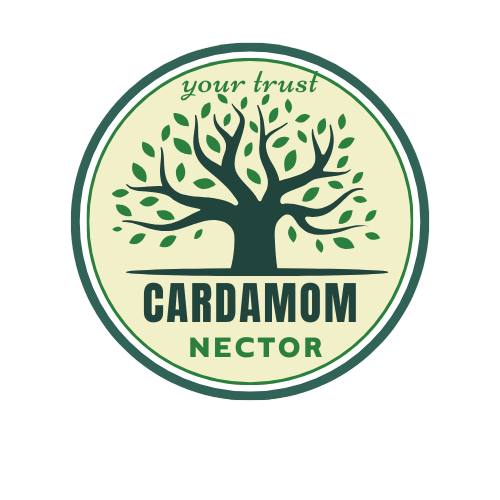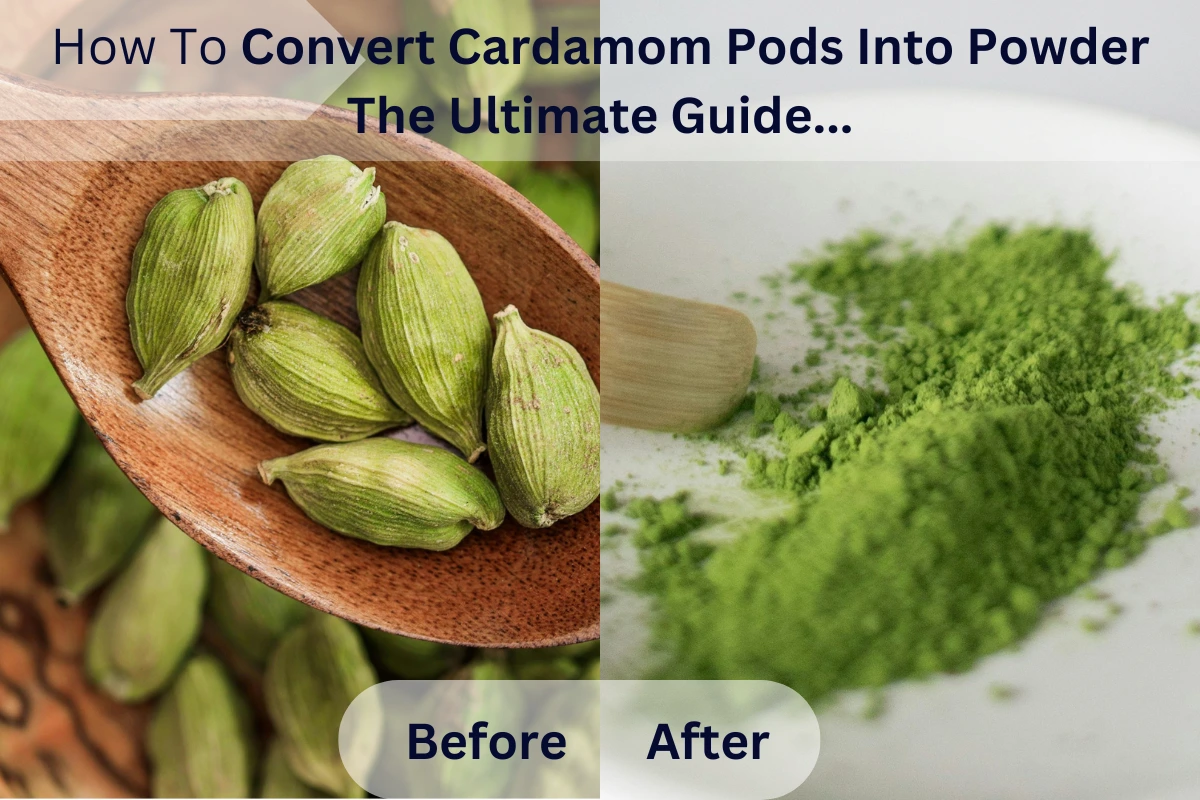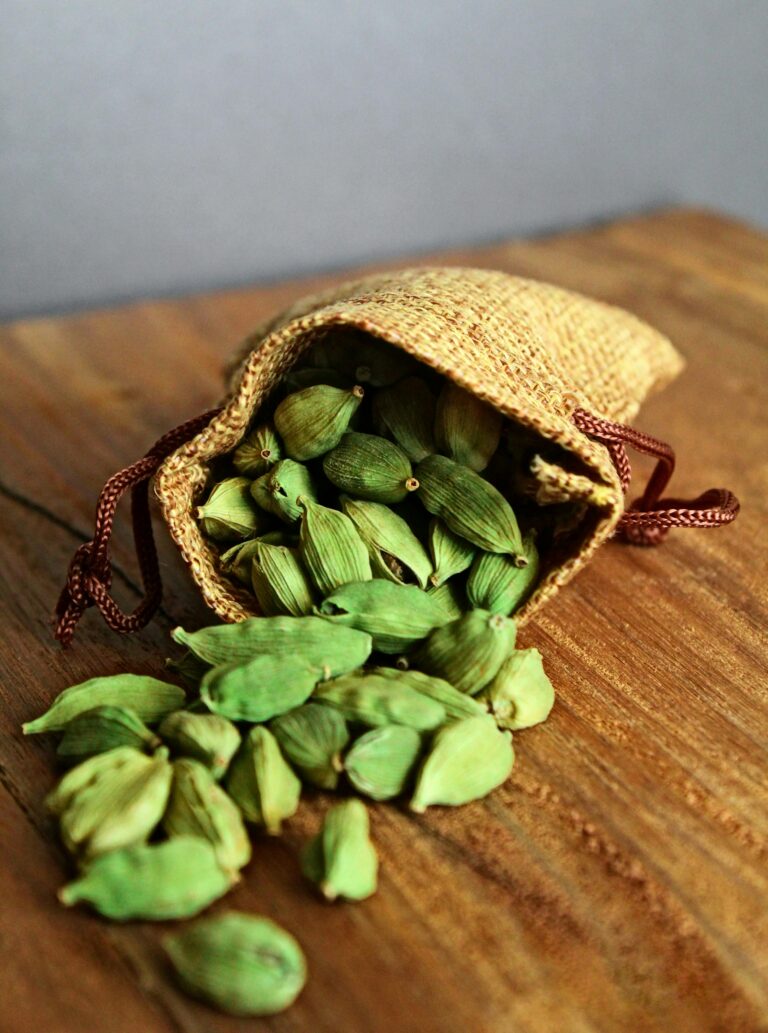How to Convert Cardamom Pods To Powder
Convert Cardamom Pods to Powder
A Step-by-Step Guide for Every Kitchen Enthusiast
If you’re anything like me, your spice drawer is your treasure chest, and cardamom pods are the gems. Their warm, sweet, and slightly citrusy Aroma can transform even the simplest dishes into culinary masterpieces. But let’s be honest—using cardamom pods whole can be a hassle, especially when you’re in a rush. That’s where cardamom powder comes to the rescue!
Let me tell you a quick story. A few months ago, I was hosting a surprise tea party for my best friend. With guests arriving in an hour, I realized I needed freshly brewed chai, and nothing screams chai like freshly ground cardamom. Thankfully, I had a small stash of homemade cardamom powder. It saved me from the frantic last-minute pod-crushing, and the tea turned out so fragrant that everyone kept asking for the recipe! That day, I vowed never to run out of cardamom powder again.
Let me share how you can easily convert cardamom pods into powder, saving precious time while keeping your dishes aromatic and delicious.
Why Make Your Cardamom Powder and Why It’s Worth It
Despite the challenges, making your cardamom powder is undeniably beneficial. You gain control over quality, taste, and purity while enjoying the satisfaction of crafting something from scratch. Fresh powder’s enhanced Aroma and flavour will elevate your dishes to the next level.
Ultimately, the effort you put into grinding your cardamom is a small price to pay for the unbeatable taste and health benefits you’ll enjoy. It’s a simple way to infuse your cooking with love and authenticity!
Making cardamom powder at home comes with a host of advantages:
Unmatched Freshness and Aroma:
When you grind cardamom seeds, the resulting powder is vibrant and flavorful. On the other hand, store-bought powders can sit on shelves for months, losing their potency.
Customization:
You can grind just the amount you need, ensuring you always have fresh powder without worrying about it going stale.
Pure and Additive-Free:
Many store-bought powders contain fillers or preservatives to extend shelf life. Homemade powder is 100% natural, giving you peace of mind about what’s going into your food.
Cost-Effective:
Whole cardamom pods are often more economical, especially in bulk. Making your powder saves money while ensuring superior quality.
Zero Waste:
Even the pod husks can be repurposed for tea, infusions, or fragrant simmering pots, making the process eco-friendly and practical.
The Challenges and How to Overcome Them
While making cardamom powder at home has clear benefits, it’s fair to acknowledge some of the challenges:
- Time and Effort: Extracting seeds from pods, grinding them, and sifting the powder can be labour-intensive. However, a spice grinder or a high-speed blender can significantly reduce the time and effort required.
- Shorter Shelf Life: Homemade powder doesn’t have preservatives, so that it won’t last as long as store-bought varieties. The solution? Grind small batches you can use within a month to enjoy peak freshness.
- Equipment Requirements: Not everyone has a spice grinder or blender. Mortar and Pestle are traditional yet practical tools for smaller quantities if you don’t.
- Skill and Consistency: Achieving a fine, uniform powder might take practice, but sifting through a mesh sieve can help eliminate coarse bits.
What You’ll Need
- Cardamom Pods: Green cardamom pods work best for most recipes.
- Mortar and Pestle (optional): Great for small quantities.
- Spice Grinder or Blender: Ideal for larger batches.
- Fine Mesh Sieve: To separate any coarse bits.
- Airtight Container: For storing the powder.
Step-by-Step Guide to Making Cardamom Powder
1. Gather Your Cardamom Pods
Start with the best quality green cardamom pods for optimal flavour and Aroma. Look for pods that:
- Feel firm to the touch, not brittle or soft.
- Have a vibrant green colour, which indicates freshness.
- Avoid pods that are pale, shrivelled, or have any visible cracks, as they may be old or dried out.
- Tip: Always buy whole pods instead of pre-ground powder, as the seeds inside retain their freshness for longer.
2. Dry the Pods
Drying the pods helps make the seeds easier to grind and brings out their oils for a more aromatic powder. Here are two methods:
- Air Drying: Spread the pods on a plate or tray in a warm, dry area. Leave them for 1-2 days until they feel slightly crisp to the touch. This method is ideal if you’re not in a hurry.
- Quick Method: Place the pods in a dry pan over low heat and toast them for 1-2 minutes. Keep stirring them gently to avoid burning. The goal is to warm them just enough to release their natural oils.
- Tip: Toasting the pods enhances the flavour and makes your kitchen smell amazing!
3. Remove the Seeds
Once the pods are dried, it’s time to extract the flavorful seeds inside. Here’s how:
- Use a mortar and Pestle or gently press the pods with a rolling pin to crack them open.
- Separate the tiny black seeds from the husks, which are the outer shells.
- Discard the husks, or save them to infuse tea, rice, or desserts with a subtle cardamom aroma.
- Tip: If you’re working with a large batch, place the cracked pods in a sieve and shake gently. The seeds will fall through while the husks stay behind.
4. Grind the Seeds
Grinding the seeds is where the magic happens. You can use:
- Spice Grinder/Blender: Add the seeds to the grinder and pulse in short bursts until you achieve a fine, consistent powder. Be careful not to overheat the seeds, as this can reduce their Aroma.
- Mortar and Pestle: Grind the seeds by hand using steady circular motions for smaller quantities. While this takes some effort, it gives you complete control over the Texture.
- Tip: If you’re using a blender or grinder, pulse in short bursts and scrape down the sides occasionally to ensure even grinding.
5. Sift the Powder
After grinding, some larger pieces may remain. To ensure a smooth and fine powder:
- Pass the ground powder through a fine mesh sieve.
- Re-grind any coarse bits left behind and sift again if necessary.
- Tip: A super-fine powder is perfect for desserts, while a slightly coarse texture works well for brewing tea or adding savoury dishes.
6. Store Properly
To maintain the freshness and Aroma of your cardamom powder, follow these steps:
- Transfer the powder into an airtight container, like a glass jar with a tight-fitting lid.
- Store it in a cool, dark place, away from heat and moisture.
- Use the powder within 1-2 months for the best flavour, as it loses potency over time.
- Tip: For longer storage, store the powder in the freezer. Make sure the container is completely sealed to prevent moisture from entering.
By following these steps and tips, you’ll have freshly made cardamom powder bursting with flavour. Whether adding it to chai, desserts, or savoury dishes, you’ll notice the difference fresh cardamom powder makes in your cooking!
Tools Required to Convert Cardamom Pods to Powder
As someone who’s spent years in the kitchen, I’ve learned the importance of having the right tools when converting cardamom pods into fine powder. Over the years, I’ve tried several methods, each with benefits and challenges. Let me walk you through the tools I’ve used, and I’ll share the advantages and disadvantages of each to help you make an informed choice.
1. Mortar and Pestle
Benefits:
- Traditional and Authentic: This tool is the oldest method I’ve used, and it connects me to how cardamom was ground for centuries. The grinding process can bring out the full flavour of the cardamom.
- Control: You have complete control over the Texture and can adjust the coarseness or fineness of the powder to your liking.
Disadvantages:
- Time-consuming: Grinding with a mortar and Pestle requires some elbow grease, especially when you have much to process.
- Physical Effort: Grinding cardamom in bulk can be tiring and a hassle if you’re in a rush.
2. Spice Grinder (Electric)
Benefits:
- Speed and Efficiency: If you’re like me and constantly juggling tasks in the kitchen, an electric grinder is a lifesaver. It’s fast and gets the job done with minimal effort.
- Consistency: You can achieve a fine, even powder every time without manual effort.
Disadvantages:
- Loss of Flavor: Electric grinders can sometimes cause the spice to lose some aromatic oils due to the heat generated during grinding.
- No Control Over Texture: While it’s great for getting a fine powder, it’s not the ideal tool for a coarser grind.
3. Coffee Grinder
Benefits:
- Multi-purpose: I often use this tool in my kitchen, not just for coffee! It also works wonderfully for grinding cardamom.
- Fine Powder: It delivers a smooth, fine powder quickly, making it great for recipes that require a delicate texture.
Disadvantages:
- Cleaning Challenges: If you’ve used the grinder for coffee, you’ll need to clean it thoroughly before grinding cardamom. Otherwise, you might end up with a slightly flavoured spice.
- Can Be Noisy: It’s not the quietest kitchen tool, which can be annoying if you grind early in the morning.
4. Manual Hand Grinder
Benefits:
- Compact and Portable: I’ve used a manual hand grinder when I need something small and easy to handle. It’s ideal if you don’t need to grind a lot at once.
- No Electricity Needed: This tool is perfect if you’re in a place without electricity or want to save on energy.
Disadvantages:
- It Takes Time: Like the mortar and Pestle, it requires more effort than electric grinders. It might not be the best choice if you’re in a hurry.
- Limited Capacity: It’s great for small batches but not practical for grinding large quantities of cardamom.
Each tool has its place depending on your needs, lifestyle, and kitchen setup. I recommend starting with a mortar and Pestle for authenticity, but if you’re a busy cook like me, the electric grinder might be your best bet for quick, consistent results. Always choose what feels most comfortable for you!
10 Pro Tips for Perfect Cardamom Powder

1. Grind in Small Batches
Cardamom is at its aromatic best when freshly ground, but its potency diminishes over time. Only grind as much as you’ll use in about a month to ensure your dishes always have the most vibrant flavour. Small batches may seem like extra effort, but the payoff in taste and Aroma is worth it.
2. Freeze for Longevity
Don’t let it stale if you’ve made a large batch of cardamom powder! Store the extra powder in an airtight container and place it in the freezer. Freezing slows down the degradation of essential oils, keeping your powder fresh for up to six months. When using frozen powder, let it come to room temperature before opening the container to prevent condensation from ruining its Texture.
3. Blend with Sugar
When preparing desserts like cakes, cookies, or puddings, consider grinding your cardamom seeds with a small amount of sugar. The sugar acts as an abrasive, helping to break down the seeds into an even finer powder. This pre-sweetened mix dissolves easily in batters and adds extra sweetness and flavour.
4. Toast for Depth of Flavor
If you want a more intense and smoky aroma, lightly toast the seeds before grinding them. Heat them in a dry pan over low heat for a minute or two until their Aroma is released. Be careful not to burn them; even a slight scorch can lead to bitterness. Toasted cardamom works wonders in both savoury dishes and spice blends.
5. Experiment with Spices
Cardamom is incredibly versatile and pairs beautifully with other spices. Try blending it with cinnamon, nutmeg, or cloves to create your spice mixes for baking or beverages. Mix it with star anise and fennel seeds for a homemade chai masala blend.
6. Invest in a Quality Grinder
A good spice grinder or high-speed blender can make all the difference when grinding cardamom seeds. A poor-quality grinder might leave you with uneven particles, which can affect the Texture of your dishes. Use a grinder with adjustable settings to control the consistency for the smoothest results.
7. Add a Pinch of Salt
Mix a tiny pinch of salt with your cardamom powder for savoury dishes before adding it to your recipe. The salt helps balance and enhance the spice’s natural sweetness, making it even more flavorful in curries, stews, and rice dishes.
8. Store Away from Light and Heat
Even when stored in airtight containers, cardamom powder can lose its Aroma if exposed to light or heat. Keep your container in a pantry or cupboard, away from the stove or windows. Proper storage can significantly extend the shelf life and flavour of your powder.
10. Know When to Use the Husks
While most recipes call for just the seeds, don’t overlook the value of the husks. They’re not as potent but still carry a subtle aroma. Add the husks to tea, rice, or even simmering soups for a gentle infusion of flavour.
Following these pro tips ensures your homemade cardamom powder is always fresh, fragrant, and ready to elevate any dish. Whether baking, brewing, or cooking, these little tweaks will make a big difference!
The Versatile Uses of Cardamom Powder in Everyday Life

Cardamom powder, made from the aromatic seeds of the cardamom pod, is a pantry gem that can elevate your culinary creations, enhance your health, and even add a touch of luxury to your self-care routine. Let’s explore how you can use this fragrant spice daily.
1. Culinary Uses of Cardamom Powder
Sweet Dishes
Cardamom powder is a staple in desserts around the world. Its sweet, floral aroma pairs beautifully with sugar and dairy-based recipes.
- Baked Goods: Add a pinch to cookies, cakes, muffins, or bread for a subtle exotic flavour. Think of it as a secret ingredient for next-level baking.
- Traditional Sweets: In South Asia, Cardamom is essential in classics like kheer (rice pudding), gulab jamun, and laddoos. Middle Eastern desserts like baklava and Turkish delights also shine with cardamom.
- Custards and Ice Creams: Stir a bit into custard, yogurt, or homemade ice creams for an elegant twist.
Beverages
Warm drinks become irresistible with a dash of cardamom powder:
- Chai Tea: A must-have in Indian masala chai, cardamom blends with spices like ginger and cloves to create a comforting, spiced tea.
- Coffee: Add a pinch to your coffee grounds before brewing for a Middle Eastern-inspired aromatic brew.
- Hot Chocolate: Stir a sprinkle into hot chocolate for a luxurious upgrade.
Savory Dishes
Cardamom isn’t just for sweets. Its complex flavour can elevate savoury dishes:
- Curries and Stews: A small amount of cardamom powder can enhance the depth of flavours in Indian curries and Middle Eastern stews.
- Rice and Pilafs: Sprinkle some while cooking rice dishes like biryani, pulao, or pilafs for an earthy, aromatic touch.
- Meat Rubs: Mix cardamom with spices like cumin, coriander, and paprika to create a flavorful rub for chicken, lamb, or beef.
Everyday Snacks
Why stop at meals? Cardamom powder makes snacks more exciting. Sprinkle it over popcorn, roasted nuts, or granola for a warm, spiced treat.
2. Health and Wellness Benefits
Digestive Aid
Cardamom has long been used to soothe digestion. After meals, a cup of warm water with a pinch of cardamom powder can help reduce bloating and indigestion.
Oral Health
Cardamom’s antimicrobial properties make it great for oral hygiene. Use it in homemade mouth rinses or chew on powder to freshen your breath naturally.
Stress Relief
Cardamom’s soothing Aroma can help calm your mind. Add it to herbal teas or warm milk before bedtime to promote relaxation and restful sleep.
Anti-Inflammatory and Detoxifying
Rich in antioxidants, cardamom powder helps combat inflammation and supports the body’s detoxification process. Regular use of food or drinks can help boost overall wellness.
3. Beauty and Self-Care
Skin Care
Cardamom powder is a secret ingredient for glowing skin. Its antibacterial and antioxidant properties make it a great addition to DIY face masks or scrubs.
- Mix it with honey and yogurt for a quick, brightening face mask.
- Add a pinch to body scrubs for a spa-like experience.
Aromatherapy
The rich, warming scent of cardamom powder makes it ideal for aromatherapy. Add a bit to homemade candles, potpourri, or bath soaks to create a calming environment.
Hair Care
When combined with coconut oil, cardamom powder can be used as a scalp treatment to reduce dandruff and promote healthier hair growth.
4. Household Uses
Natural Air Freshener
The pleasant, spicy Aroma of cardamom can refresh your home. Simmer a pot of water with cardamom powder, cinnamon sticks, and orange peels for a natural, chemical-free air freshener.
Flavor Booster for Food Storage
Add a sprinkle of cardamom powder to your sugar containers or jars of dried fruits to keep them flavorful and fresh.
Gift Idea
Homemade spice blends featuring cardamom powder make thoughtful gifts. Create a chai spice mix or a dessert seasoning and package it in small jars for friends and family.
5. Cultural and Ritual Uses
In many cultures, cardamom powder holds special significance.
- Rituals and Ceremonies: It is often used in religious offerings, weddings, and festivals.
- Medicinal Traditions: Ayurveda and traditional Chinese medicine value cardamom for its healing properties.
Common Mistakes to Avoid When Making Cardamom Powder
Making cardamom powder at home is simple and rewarding, but a few pitfalls can compromise its quality. Let’s look at the most common mistakes and how to avoid them to achieve the perfect aromatic powder every time.
1. Grinding Too Much at Once
Grinding a large batch at once might seem convenient, but cardamom powder loses its flavour quickly after being ground. The essential oils that give cardamom its Aroma dissipate over time. Instead, grind only the amount you’ll use within a month for the freshest flavour.
2. Using Low-Quality or Old Pods
The quality of your cardamom pods directly impacts the flavour of the powder. Avoid using pale, shrivelled, or brittle pods, as they’ve likely lost their essential oils. Always choose vibrant green, firm pods for the best results.
3. Skipping the Drying Step
Grinding wet or moist cardamom pods can result in clumps or uneven powder. Drying the pods—either by air-drying or lightly toasting them—makes grinding easier and releases more of the spice’s natural oils. Don’t skip this crucial step!
4. Over-Toasting the Pods
While toasting enhances flavour, overdoing it can scorch the seeds, leaving them bitter. Toast the pods gently over low heat for 1-2 minutes, stirring constantly to prevent burning.
5. Using the Wrong Grinding Tool
A low-quality grinder or an unsuitable tool can leave you with uneven or coarse powder. For the best results, use a spice grinder, a high-speed blender, or a mortar and Pestle for small quantities.
6. Forgetting to Sift the Powder
Skipping the sifting step can leave your powder with uneven particles. Always use a fine mesh sieve to ensure a smooth, delicate texture. Re-grind any leftover coarse bits for consistency.
7. Improper Storage
Storing cardamom powder in a poorly sealed container or exposing it to light, heat, or moisture will cause it to lose its Aroma and flavour quickly. For the most extended shelf life, use an airtight container and store it in a cool, dark place.
By avoiding these common mistakes, you’ll ensure your homemade cardamom powder is fresh, flavorful, and perfect for enhancing your dishes. With some care, this aromatic spice will elevate your cooking and baking to the next level!
Store-Bought Cardamom Powder vs. Homemade: Which Is Better?
Regarding cardamom powder, the debate between store-bought and homemade often leaves home cooks wondering which option is best. Both have pros and cons, but let’s break it down to help you decide which works for you.
1. Freshness and Aroma
- Homemade: Cardamom powder made at home is as fresh as it gets. Grinding the seeds releases essential oils that give cardamom its signature aroma, which diminishes quickly over time. Homemade powder guarantees you’re using it at its peak flavour.
- Store-Bought: Most commercial powders are made in bulk and can sit on shelves for months. Their fragrance and flavour may have faded by the time they reach your kitchen.
Winner: Homemade. Nothing beats the freshness of grinding cardamom yourself.
2. Purity and Quality
- Homemade: You control the quality of the pods, ensuring only premium seeds go into your powder. There are no fillers, additives, or preservatives—just pure cardamom.
- Store-Bought: Many store-bought powders may include additives or fillers to reduce costs. Even when labelled “pure,” the quality of the cardamom used might not be as high as what you would choose yourself.
Winner: Homemade. It offers 100% control over what goes into your spice.
3. Convenience
- Homemade: Making cardamom powder at home requires time and effort. It’s a multi-step process, from cracking the pods to grinding and storing.
- Store-Bought: Pre-ground powder is ready to use, making it a convenient choice for busy cooks. It’s a quick solution when you need cardamom in a pinch.
Winner: Store-Bought. It saves time and effort, especially for those with busy schedules.
4. Cost
- Homemade: While green cardamom pods can be expensive, grinding your powder is often more cost-effective in the long run. You get more bang for your buck since store-bought powders include markups for packaging and branding.
- Store-Bought: Initially cheaper, but the quality-to-price ratio may not match the value of homemade powder. You might use more to achieve the same flavour, which could increase the cost over time.
Winner: Homemade. A little effort upfront saves money and offers better value.
5. Flavor Intensity
- Homemade: Freshly ground powder has an unparalleled depth of flavour. The vibrant, complex taste shines in both sweet and savoury dishes.
- Store-Bought: Pre-ground powder often lacks the intensity of homemade due to oxidation and loss of essential oils over time.
Winner: Homemade. The flavour is noticeably more prosperous and more potent.
6. Shelf Life
- Homemade: Without preservatives, homemade powder should be used within 1-2 months to maintain its Aroma and flavour.
- Store-Bought: Commercial powders often include preservatives, giving them a longer shelf life (sometimes up to a year). However, this comes at the cost of freshness.
Winner: Store-Bought. It lasts longer but at the expense of peak quality.
7.Customization (Flavor Blends)
- Homemade: To create unique spice mixes for different dishes, you can fully control the flavour profile and blend cardamom with other spices like cinnamon, cloves, or nutmeg.
- Store-Bought: Typically, store-bought cardamom powder is a single, pure product with no additional flavour options or customization.
- Winner: Homemade. You can experiment and create personalized spice blends to suit your cooking style.
8.. Control Over Texture
- Homemade: When making your cardamom powder, you can grind it to the exact Texture you prefer—whether you want a fine powder or a slightly coarser grind for specific recipes.
- Store-Bought: Pre-ground cardamom powder may have inconsistent textures and be either too fine or coarse, depending on how it’s processed.
- Winner: Homemade. It allows you to adjust the Texture based on your recipe needs.
9. Availability
- Homemade: If you don’t have cardamom pods, you’ll need to buy them to make your powder, which could require some planning.
- Store-Bought: Commercially available cardamom powder can be found year-round in grocery stores, making it a convenient option if you’re in a pinch.
- Winner: Store-Bought. It’s always available when you need it, without extra preparation.
10. Packaging Waste
- Homemade: Homemade cardamom powder typically doesn’t involve packaging waste, as you use the pods directly and store the powder in reusable containers.
- Store-Bought: Store-bought cardamom powder often comes in plastic or glass containers, contributing to packaging waste.
- Winner: Homemade. It’s a more eco-friendly option as it reduces packaging waste and the need for disposable containers.
Here’s a table comparing Store-Bought and Homemade cardamom powder based on the topics we discussed:
Topic Store Homemade
Freshness and Aroma ✘ ✔
Purity and Quality ✘ ✔
Convenience ✔ ✘
Cost ✘ ✔
Flavour Intensity ✘ ✔
Shelf Life ✔ ✘
Customization (Flavor Blends) ✘ ✔
Control Over Texture ✘ ✔
Availability ✔ ✘
Packaging Waste ✘ ✔
- ✔ indicates the suitable option.
- ✘ Indicates the less suitable option.
This table clearly shows when store-bought is better and when homemade cardamom powder is superior.
The choice is yours.
- Choose Homemade if you prioritize freshness, flavour, purity, and quality. It’s perfect for those who love the culinary experience and are willing to spend extra time.
- Choose Store-Bought if convenience and longer shelf life are more critical, especially if cardamom isn’t a regular spice.
Ultimately, the choice comes down to your priorities. But if you want the best cardamom powder, homemade is the clear winner—it’s fresher, more prosperous, and far more satisfying!





